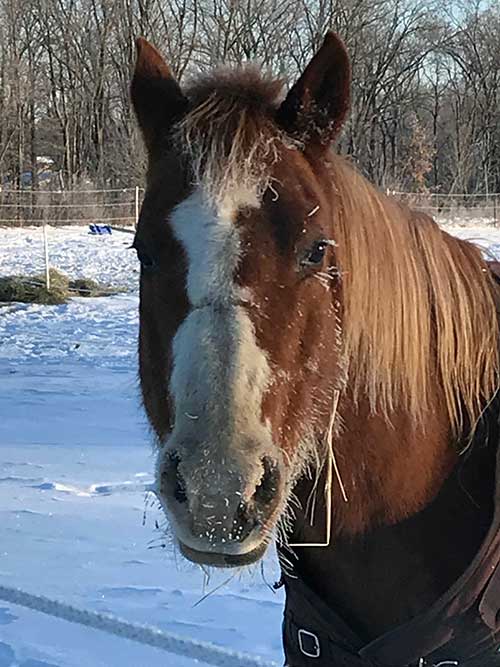
A young rider leads a horse out for exercise in the snow. Blanketing helps horses maintain their body temperature in the cold. Blankets also decrease hair coat production, and keep the majority of the coat mud-free.
When given the opportunity to acclimate to colder weather, horses are often happy to spend their days outdoors during winter time. By following a few key guidelines in grooming, exercise, and feeding, you can keep your horse healthy, happy, and handsome in the cold.
Winter Grooming Tips
Winter grooming can be a challenge due to cold temperatures, long hair coats, and often lots of mud. How do you ride in the elements while keeping your horse healthy and happy? Try these grooming tips:
- First, consider blanketing. Blankets decrease hair coat production, and keep the majority of the coat mud-free.
- Use deep toothed curry combs and brushes. Thoroughly brush the areas where tack is placed — saddle pad and girth area and the head. The legs should be examined and at least receive cursory brushing, to ensure no cuts or swellings are present.
- If your horse is shod, consider snow pads. Be sure to pick out your horse’s feet daily to remove packed snow and mud, so bruising doesn’t occur on the sole.
- Clip the “feathers” off the back of your horse’s pasterns — this will allow them to dry faster, helping to prevent bacterial skin diseases.
Winter Warm-up
Why is warming up so critical? Warm-ups are an important part of any exercise program as they stretch the muscles, increasing flexibility and range of motion. Warming up should start with some basic stretching, which can aid in “loosening up” stiff or arthritic joints, and may even prevent injuries.
According to a 2010 study (Frick, Journal of Equine Veterinary Science), stretching exercises may help relieve pain and strengthen muscles. Experts agree that 10 — 20 minutes of warm-up is essential, especially in the winter, to increase circulation into muscles prior to working. Warm-ups may include:
- A walk for five minutes on a long rein, encouraging your horse to stretch through the neck and back.
- Trot in large circles for five minutes.
- Collect your horse and trot in smaller circles, counter-flexing, and performing walk trot transitions.
- Canter large circles to smaller circles each direction.
Remember, just to maintain baseline fitness, your horse needs 15 — 25 minutes of exercise five times per week.

This horse is feeling the winter chill. Winter grooming can be a challenge due to cold temperatures, long hair coats, and often lots of mud. But by following a few key guidelines, you can keep your horse healthy, happy, and handsome in the cold.
Winter Cool-down
Cool-down periods are important to allow the increased circulation to remove waste products from muscles so they don’t build up and cause soreness, and to allow the hair, coat, and skin to dry. They also allow the heart to slow down slowly and the horse to stop blowing. Consider the following cool-down options:
- A fleece cooler will help wick moisture away and dry the hair and skin faster, but never place a turnout or overnight blanket on a damp horse. This can lead to decreased skin immunity and bacterial or fungal infections.
- Cool-downs are down under saddle or in-hand at a walk, and should last 5 — 15 minutes (depending on level of workout) until your horse is cool and dry, and her respiratory rate is back to normal.
- A quick brush-off of the sweat-dried areas, to fluff up the hair, will help protect the skin and improve insulation against the cold.
Other Important Winter Tips
Most horses do NOT need increased feed just because the weather turns cold. However, exceptions to this rule include: foals, “hard-keepers”, older (geriatric) horses, and extreme temperatures.
In temperatures consistently below 30 degrees Fahrenheit, increase feed by 1 — 2 pounds for each 10 degrees below 30 Fahrenheit. This should preferably be in hay (i.e. 1 extra flake of hay/day at 20 Fahrenheit, 2 extra flakes at 10 Fahrenheit, etc.). Hay generates more heat throughout the day than grain.
Also, access to unlimited amounts of fresh water is the most important nutrient for your horse.
Be sure to provide adequate shelter that is out of the wind and covered from snow/sleet — with enough space or multiple shelters to allow all horses access. If this is impractical due to the number of horses or other constraints, then stalling horses for part of each day, and blanketing with a waterproof turnout should be sufficient.
